Places to Visit in the Princes' Islands
- Published Date
- 13 May 2023, 22:46
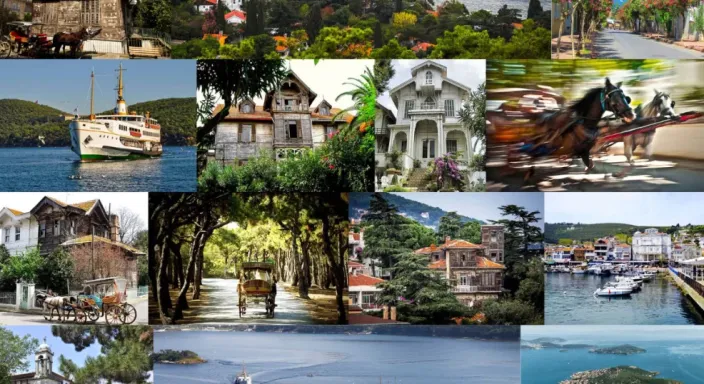
Tour Organizer
- Published Date
- 13 May 2023, 22:46
- Category
- Blogs
The Prince Islands are among the places of interest for tourists with their history, nature, culture and many features that go back to the Helinistic period. It also contains many historical and architectural artifacts. In this blog post, we bring together historical places.
- Aya Yorgi Church (Büyükada)
- Old Orphanage (Büyükada)
- Trotsky House (Büyükada)
- Con Pasha Mansion (Büyükada)
- Islands Museum (Büyükada)
- Dilburnu Nature Park (Büyükada)
- Hamidiye Mosque (Büyükada)
- Greek Orthodox Seminary (Heybeliada)
- Aya Yorgi Cliff Monastery (Heybeliada)
- Naval High School (Heybeliada)
- Değirmen Burnu Recreation Area (Heybeliada)
You can find more information about these historical places in our article below. Buy our Prince Islands Tour to visit the wonders of nature and see these historical places.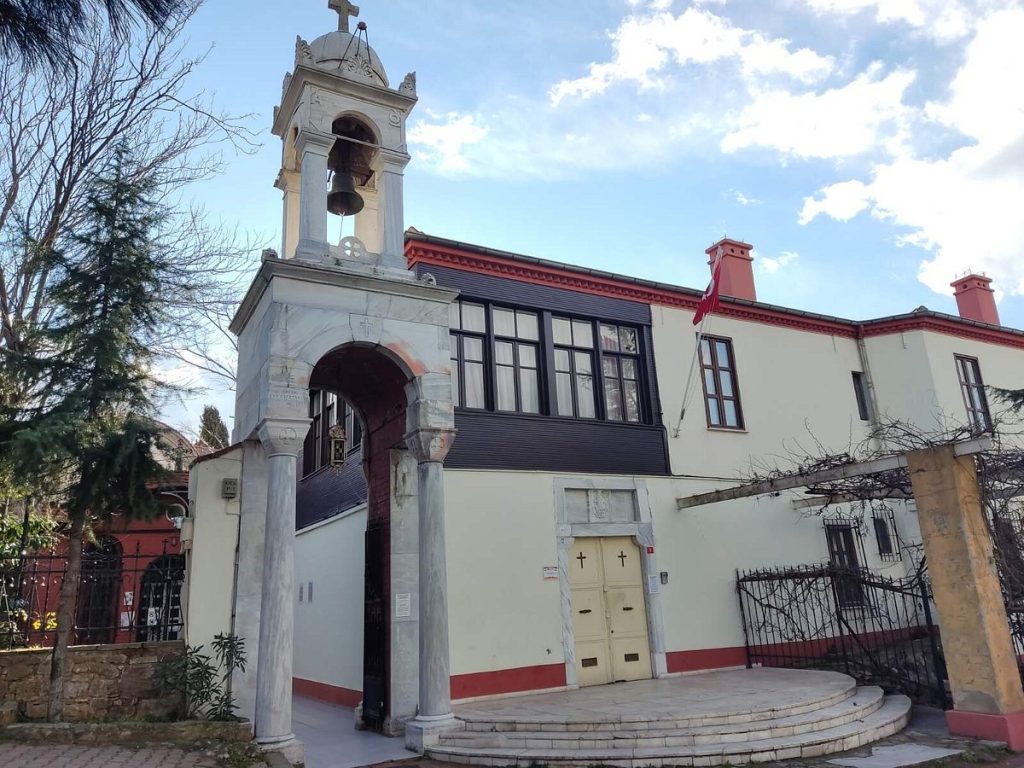
1- Aya Yorgi Church (Büyükada)
Hagia Yorgi Church is located on Büyükada in Istanbul. According to the information obtained from the Patriarchate records, this place was built in 1751. The small church, chapel and prayer place built on this date are known as the old church. This small, two-story, tiled building is visited by millions of tourists.
The church made of cut stone behind the bell tower on the hill is known as Yeni Aya Yorgi Church. This place was also built in 1905 and opened for use in 1909.
Aya Yorgi Church, which has thousands of years of history, is located on Yüce Tepe, at an altitude of 204 meters, at one of the points close to the sky of Büyükada. His name is M.S. Aya Yorgi Church, which was named after St. Georgios of Cappadocia, who was killed for his Christian faith in the 3rd century AD, according to rumors. It was built in 963 during the reign of Byzantine Emperor Nikiforos Fokas.
This church, along with the House of the Virgin Mary in Ephesus, is one of the two pilgrimage destinations in Turkey by Christians. For this reason, every year on April 23 and September 24, this place is flooded with visitors.
Of course, these dates also have significance. In the Orthodox sect, April 23 is considered the “name day” of the Yorgos. On September 24, St. The date of commemoration of Aya Thekla, who devoted herself to the new religion spread by Paulus, the apostle of Jesus, and was miraculously saved even though she was tried to be killed many times. It is believed that those who walked to the Aya Yorgi Church barefoot and left without speaking were ‘semi-pilgrims’.
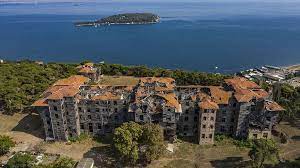
2- Old Orphanage (Büyükada)
Prinkipo Greek Orphanage, or more commonly known as Büyükada Greek Orphanage, is an orphanage that has been closed since 1964. Büyükada Greek Orphanage, which was built as a hotel on the Manastır Hill of Büyükada, was built by Alexandre Vallaury, one of the famous architects of the period.
The Büyükada Greek Orphanage, which is claimed to be the world’s first multi-storey wooden structure and still the largest wooden building, was bought by a Greek woman named Eleni Zarifi, although it was built as a hotel, because the necessary permission could not be obtained from the administration of the period.
The Greek Orphanage within the Balıklı Greek Hospital in Yedikule was moved here in 1902. Kuleli Military School was settled in the structure whose purpose of use changed over time. Later, the orphanage, which houses the Greek immigrants sent to the island by the occupation forces, was transferred to Heybeliada. The building was later closed and is still closed.
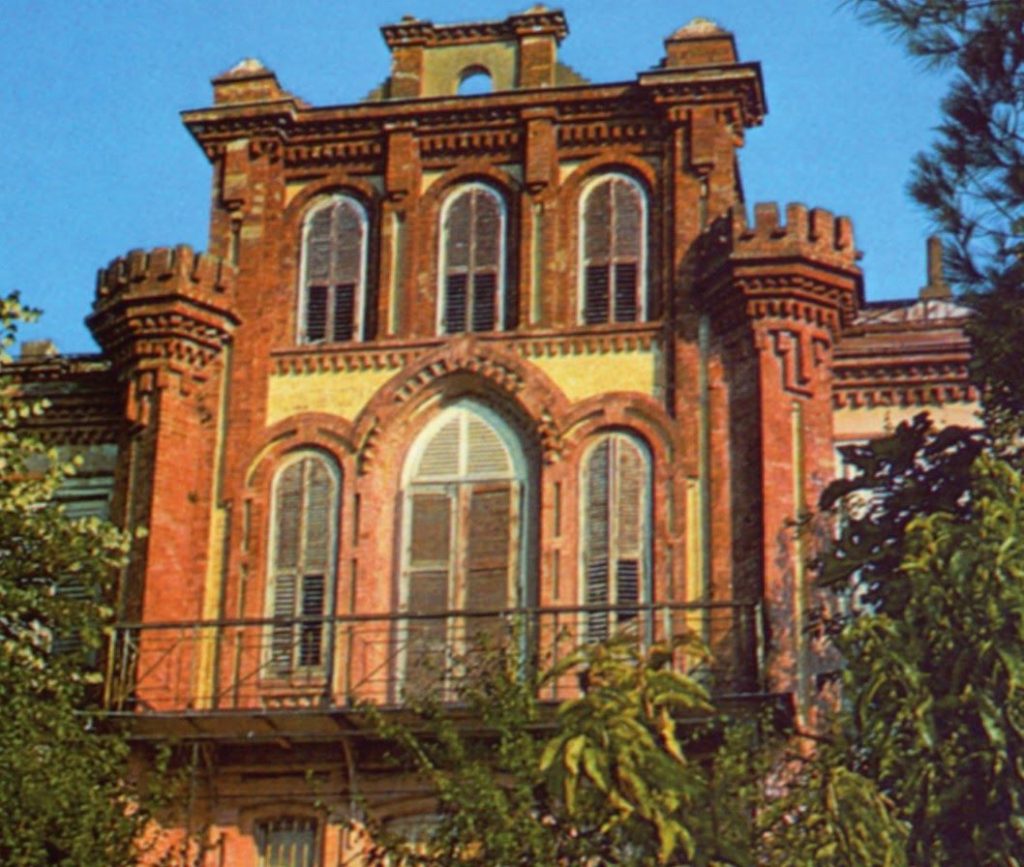
3- Trotsky House (Büyükada)
Contrary to Stalin, Trotsky was exiled first to Kazakhstan and then to Istanbul. Trotsky lived in the house on Büyükada with his second wife, Natalia, her granddaughter Sieva, and three male secretaries, who also acted as bodyguards. Trotsky’s greatest pleasures were watching the view from the balcony and going fishing with a Greek fisherman named Haralambos.
Photographer James Hughes, who came from Ireland in 2010, entered the mansion out of curiosity and photographed the interior of the mansion. The exhibition consisting of these photographs was exhibited in a small gallery in Moda with the title “Ghosts of Trotsky”, but it did not make much noise. However, the presence of Trotsky’s library and books could probably be discerned in the photographs.
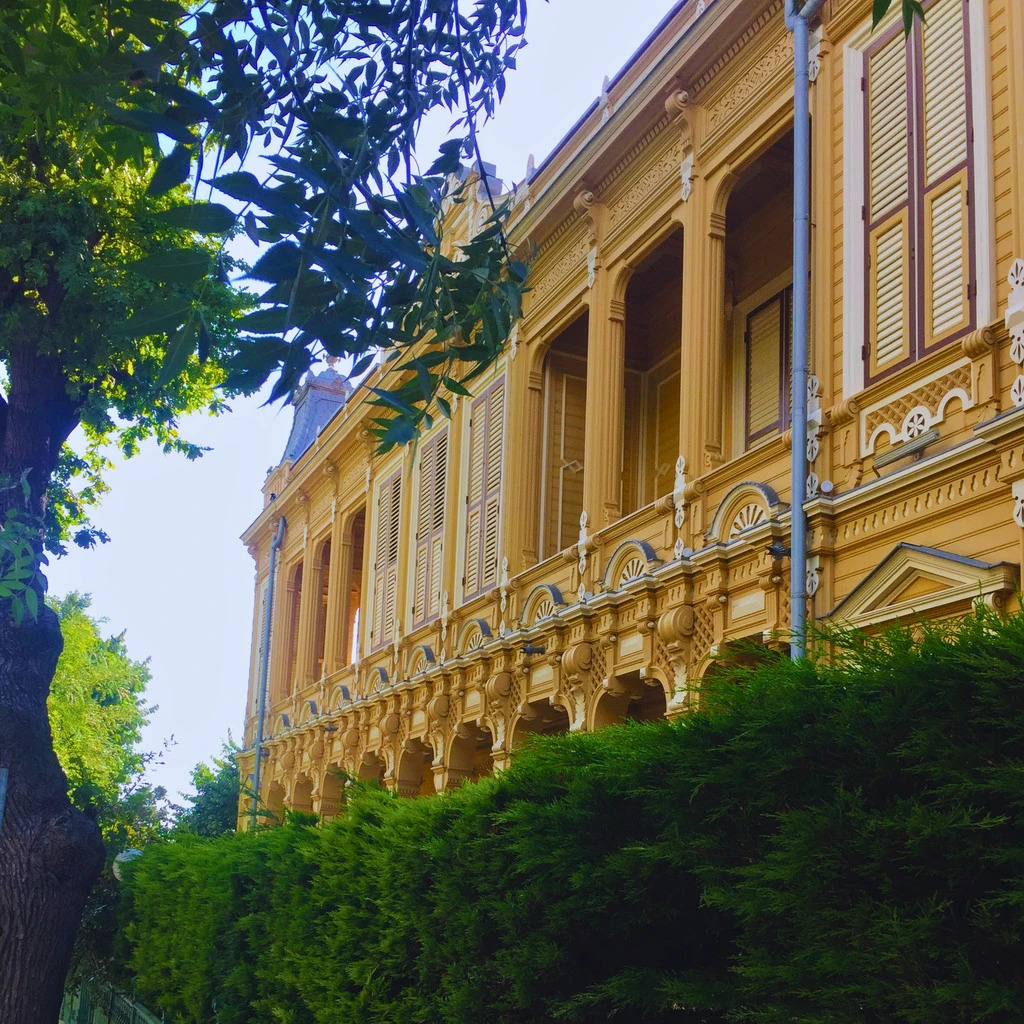
4- Con Pasha Mansion (Büyükada)
Con Pasha Mansion or John Avrimidis Mansion; It was built in Büyükada Nizam Neighborhood, Çankaya Street in the Adalar district of Istanbul. The mansion was built in 1880 by Con Pasha, who was born in Mytilene. The architect of the mansion is Achileus Policis. Con Pasha actually comes from a Venetian family. His real name is Trasiolos Yannaros. Administration-i Mahsusa, of which Con Pasha was the manager, started the first Kadıköy Islands expeditions. The ferries of that period were Baghdad, Basra and İhsan. He also died in Bursa. The tomb of Con Pasha is in the Şişli Greek Cemetery. It is located in the building block no. 68 on Çankaya Street, on an area of 2010 square meters. It is an eclectic or eclectic structure with its exterior decorations in different styles, which incorporates the architectural features of its era, and is unique.
When Con Pasha died, his house was left to his Austrian wife and children. Osman Niyazi Pasha, the Ottoman Ambassador to Berlin, was married to Con Pasha’s daughter, Alis. When the First World War began, Con Pasha was in Germany and his children were in Austria. When there was no news from the family after the war, Finance seized the mansion and put it up for sale. House respectively Emanuel Karasu, Hristo Draganis, Dr. Michal Kurromenos, Ahmet Borovalı and Müzehher Borovalı.
It is equipped with balconies with wooden columns around the mansion. Roof towers and wooden decorations are very eye-catching. There are various sculptures in the garden.
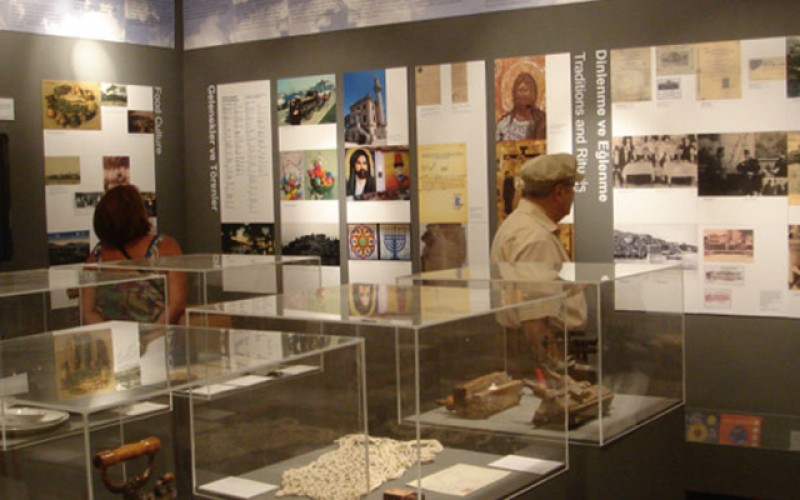
5- Islands Museum (Büyükada)
The Islands Museum is a museum located in Büyükada, in the Adalar district of Istanbul, Turkey. It was opened on 10 September 2010 with the support of Istanbul 2010 European Capital of Culture Agency. It is known as the first contemporary city museum of Istanbul. The main building of the museum, which was established in the Aya Nikola region, which is the oldest historical settlement of the island, in the south of Büyükada (Prinkipo) with the cooperation of the Islands Foundation and the Islands Municipality, hosts an old helicopter hangar that has been renovated and put into use.
The museum contains thousands of Ottoman archival documents, photographs, hundreds of documentary films, video clips documenting today’s Islands, documents obtained from the archives of public institutions serving in the Islands, oral history records, donations of the Islanders.
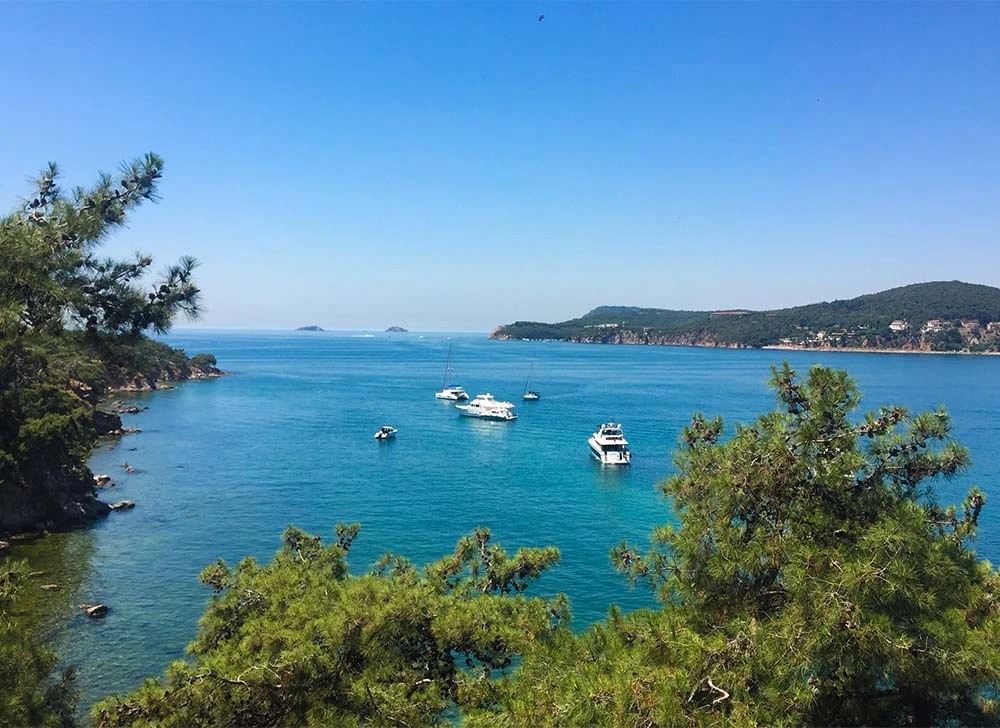
6- Dilburnu Nature Park (Büyükada)
Dilburnu Nature Park promenade area, located on Büyükada island of Istanbul province, was declared as a nature park in 2011 and is a point covered with forests with an area of approximately 7 hectares. You can have a great time at the point where the sea views, the picnic area and the blue and green meet. Apart from the Dilburnu nature park, there are also different recreation areas in the region.
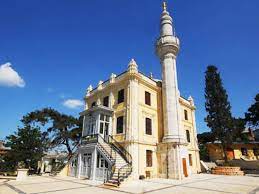
7- Hamidiye Mosque (Büyükada)
Hamidiye Mosque, which was built by the order of Abdulhamid II and opened for worship in 1895, is an elegant aesthetic structure. The cut limestone is made of stone and has two floors. The door of the cut stone minaret with a single balcony opens to the courtyard. An eight-pointed star with a crescent motif on both sides is seen on the ceiling center of the narthex; the walls and the inside of the windows are decorated with blue, dark blue and yellow pencil work.
Next to the door opening to the prayer hall, there is a wooden-enclosed wall clock showing the prayer times. The mirrored vault covering the women’s chamber is covered with lead on the outside and decorated with vegetal inside; the ceiling is equipped with three cast iron oil lamp hangers.
The central nave, supported by double elephant feet, is covered with a twelve-slice dome covered with lead on the outside and wood on the inside. The dome core is decorated with the Surah Ihlas written in gold on a black background; inner surface is embroidered with colored pencil work. In the dome arch, nine line plates are arranged. There are brass candlesticks and wooden cabinets on both sides of the mihrab with a tile arch, a circular interior and a tile belt ornament, a brass pendulum,
A Roman numeral clock appears. The pulpit is brass, the pulpit is wood-carved. The four walls and the inside of the windows are covered with floral motifs. The two-room masjid under the prayer rug-covered floor is entered through a corridor through which a door in the stairwell opens. The place, which was designed as a school while the mosque was being built, was converted into a masjid due to the students moving to another building and the increase in the Muslim community of Büyükada. The mosque was restored between 1998-2001.
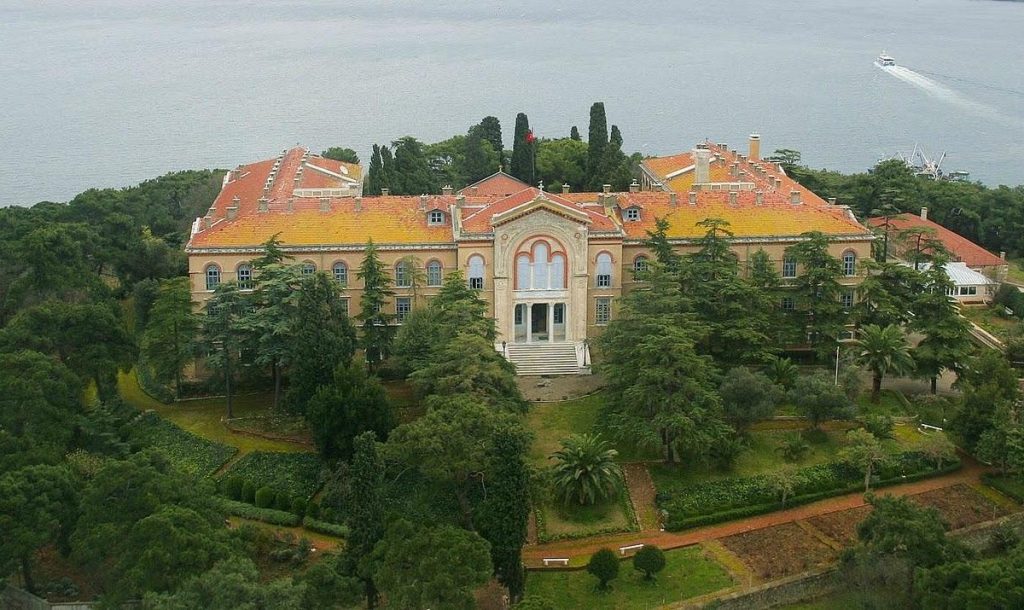
8- Greek Orthodox Seminary (Heybeliada)
Heybeliada Seminary, or known as the Greek Orthodox Seminary due to the type of theology education it provides, is a private school located in Heybeliada, also known as the Seminary in Turkey. Located on Ümit Hill in the northwest of the island, the school is the first academic school in this field, established after the Athens University Faculty of Theology.[2] The school, which started its activities in 1844 to train clergy, was called the High Orthodox Theology School until 1923. Later, it became identified with the island where it was located and started to be called Heybeliada Theological School. As a result of the decision in 1971 regarding all private colleges in Turkey to be under state control, theology education was abolished at the school due to the opposition of the Fener Greek Patriarchate, which did not consent to this change, and the school continued to provide education only at high school level. The school, which was named “Heybeliada Private Greek High School” in the 1971-1972 education period, was completely closed by the patriarchate the following year.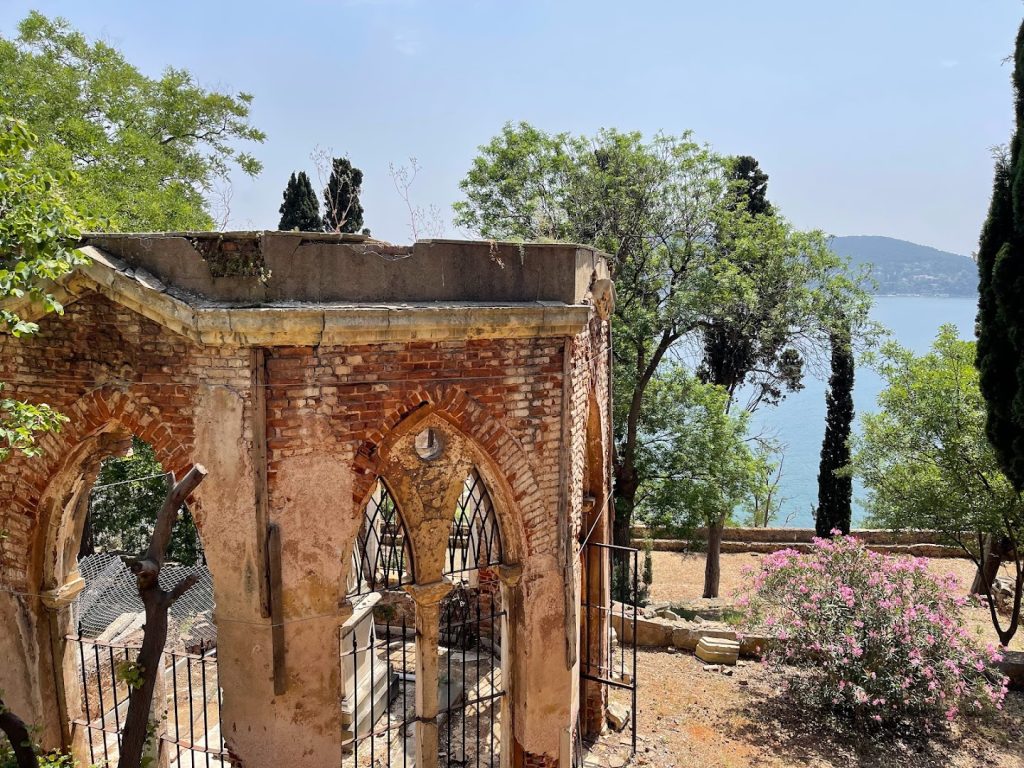
9- Aya Yorgi Cliff Monastery (Heybeliada)
The monastery (Hagios Georgios tou Kremnou) is a pink complex located on the south coast of the town (slope facing Büyükada), just beyond the Naval High School Army House. The name of the monastery “tou Kremnou” or “on the cliff” derives from the fact that the structure was built on a cliff overlooking the sea. Above the Mavi Marmara, the setting is quite beautiful, with pines, cypresses and other trees surrounding the monastery’s charming buildings; Here you will encounter a landscape reminiscent of the Greek islands in the Aegean.
The monastery is thought to have been built between 1583-93. The Reverend John Covel visited the Abbey in 1677. In his diary written on February 26 of the same year, he says: “There is another monastery here, dedicated to John the Baptist. Most of the building was destroyed and attached to the Kadıköy Metropolitan. There are books here too, but I am convinced that they are written on the same things. I didn’t bother to bring them in and see them.” British traveler Richard Pococke, who visited the island in 1739, also records that Greeks from Istanbul took shelter in St. George’s Monastery during the plague epidemic.
Bishop Ioannikos (1761-3) retired to the monastery of St. George after his duty in the Patriarchate ended. According to an inscription placed on the wall, Ioannikos had previously built a katholikon here, which he dedicated to the memory of his father, Georgios Karatzas. Ioannikis also established a “mutual teaching school” dedicated to the Holy Sepulcher of Jerusalem. Thus, the monastery became a metochion of the Patriarchate of Jerusalem, as it is today.
The Katholikon was damaged by a fire in 1882; The fire destroyed the old wooden iconostasis and all its icons, as well as the ritual furniture. Most of the icons now seen in the church are modern Russian works. The only notable icon dating back to ancient times is in the narthex. This is an icon of St. George, made by an unknown monk in 1764 and dedicated to the bishop Ioannikis, who was buried in the narthexe.
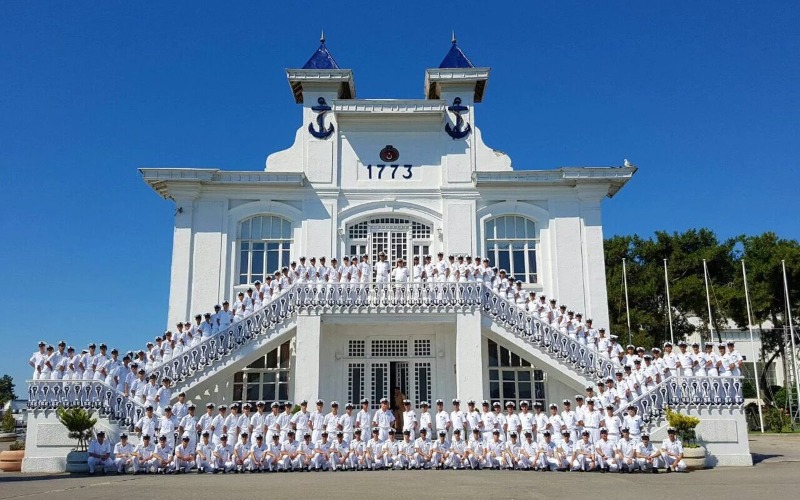
10- Naval High School (Heybeliada)
The school, which forms the core of today’s Naval Academy and Naval High School, was founded in 1773, under the name of Mühendislikhane-i Bahr-ı Hümayun, in its Shipyard, with the initiatives of Admiral Admiral Algerian Hasan Pasha. XVIII. The maritime profession, which was passed down from father to son until the 19th century, thus gained a scientific quality.
In 1782-1783, due to the new needs of the navy, a new Engineering School was built by Hasan Pasha in Camialtı and this school was merged with the Kara Mühendislikhanesi Mühensihane-i Amire in Halıcıoğlu in 1795. In 1834, the Ship Navigation section, which constitutes a part of the increasing number of students, was transferred to the Kalyoncu Barracks built by Mahmud II. Later, the Algerian Gazi Hasan Pasha Mansion, where Kasımpaşa Naval Hospital is located today, was purchased; A new Naval Engineering School with a capacity of 400 students was built here (1838), enabling the whole school to start education and training together again. gone. The exact location of the school in Heybeliada took place in the 1851-1852 academic year. In 1853, four-class high school departments were opened at the school, and with the adoption of the “Education Union Law” in 1924, the school was divided into two parts as the Naval High School and the Military Academy. The name of the school was changed to “Naval Academy and Naval High School Command” in 1928. During the Second World War, the school continued its education and training activities in Mersin; It was returned to Heybeliada in 1946-1947. Naval High School left the Naval Academy in 1963; In the 1963-1964 academic year, he started teaching in a part of the building belonging to the Naval Training Command. This building was left to the Naval High School Command in 1971. After the Naval Academy moved to Tuzla Campus in 1985, the Naval High School started education in the historical facilities vacated from the Naval Academy in the 1985-1986 academic year.
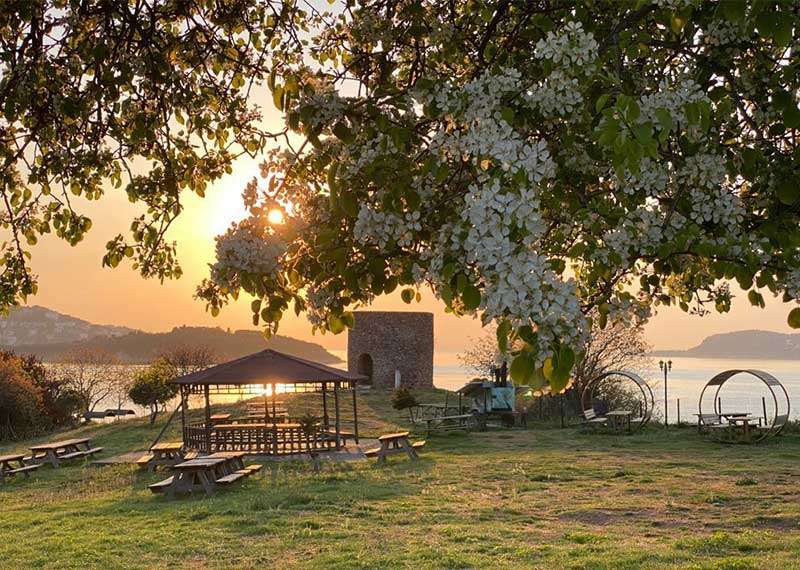
11- Değirmen Burnu Recreation Area (Heybeliada)
It is one of the most ideal spots to get away from the crowd and stress of Istanbul and to spend time for yourself. Spending a day in this beautiful place, which is located at the embrace of the sea and the forest, where various plants and animals are sheltered, will restore your energy and reduce all your nerves and stress.
Declared in 2011, Değirmenburnu Nature Park took its name from the windmill that was used as a flour mill until the end of the 19th century. It is possible to come across many different types of plants in the area. These are briefly; We can list them as Red Pine, Peanut Pine, Beach Pine, Coyote Plum, Mediterranean Laurel, Mediterranean Service, Evergreen Magnolia, Atlas Cedar, Maltese Plum, Citlenbik, Redbud, Hairy Spruce, Harlequin, Forest Ivy, Flame Tree, Crowbar. It is also possible to come across various mammals and bird species such as Squirrel, Hedgehog, Rabbit, Mole, Magpie, Sparrow, Crow.



